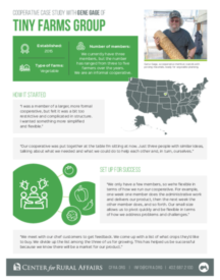Para la versión en español, por favor oprima aqui.
Established: 2015
Type of farms: Vegetable
Number of members: We currently have three members, but the number has ranged from three to five farmers over the years. We are an informal cooperative.
How it started
“I was a member of a larger, more formal cooperative, but felt it was a bit too restrictive and complicated in structure. I wanted something more simplified and flexible.”
“Our cooperative was put together at the table I’m sitting at now. Just three people with similar ideas, talking about what we needed and what we could do to help each other and, in turn, ourselves.”
Set up for success
“We only have a few members, so we’re flexible in terms of how we run our cooperative. For example, one week one member does the administrative work and delivers our product, then the next week the other member does, and so forth. Our small size allows us to pivot quickly and be flexible in terms of how we address problems and challenges.”
“We meet with our chef customers to get feedback. We come up with a list of what crops they’d like to buy. We divide up the list among the three of us for growing. This has helped us be successful because we know there will be a market for our product.”
Question and answer
Q: Did you have any mentors who provided insight or guidance in your cooperative venture?
A: Justin Jones, president of Lone Tree Foods, provided some insight and guidance. He is a close neighbor and good friend. We shared our growing experiences and valuable information with one another about what was working for us and what wasn’t.
Q: How did you begin to market your cooperative?
A: We grew our customer base by doing marketing calls and meetings with new potential customers.
Q: Did the cooperative purchase, lease, or borrow the equipment you needed?
A: Our cooperative never purchased equipment together, but we do share our individually owned equipment and tools with each other. It definitely saves each of the individual farmers considerable amounts of money over the years.
Q: Were there any helpful resources you used to answer questions you had about cooperatives?
A: I lived in Scandinavia where there are many cooperatives, so I was familiar with how cooperatives operate, which was helpful.
Q: Is there anything you wish you had known before starting a cooperative?
A: Before you have a new member join the cooperative, make sure to ask a broad array of questions to ascertain if that potential member has the same goals and visions for the cooperative. You want to ensure the new member is a good fit and that you are all on the same page.
Q: Do you have any advice for others considering forming a cooperative?
A: My advice to anyone considering forming a cooperative would be to make sure you have some knowledge about basic bookkeeping, accounting, and business plans. This is very important when it comes to making sure the cooperative and the members are actually making a profit.
About the cooperative
Tiny Farms is an informal marketing cooperative, functioning like a marketing cooperative without the legal structure. The farmers involved with Tiny Farms recognized that by working together they could reach more customers and larger markets as well as achieving greater power in the marketplace.
Cooperatives can give producers more control over their products by allowing them to bypass middlemen in the market channel. Farmers capture more of the returns that would otherwise go to others, something the Tiny Farms farmers recognized and capitalized on.
Agricultural marketing cooperatives are business organizations owned by farmers to collectively sell their products. They may assemble the products of a number of producers into larger lots to more efficiently handle products and achieve more competitive sales. For example, instead of offering kale from three different farmers, they offer kale as a product of the cooperative, from all three farmers. Marketing cooperatives can also help farmers by spreading risks and costs and have enough volume to operate a processing plant efficiently or enough to meet the demands of larger buyers.
This project is funded through a U.S. Department of Agriculture Rural Development Socially Disadvantaged Groups Grant. The Center for Rural Affairs is an equal opportunity provider and employer.


